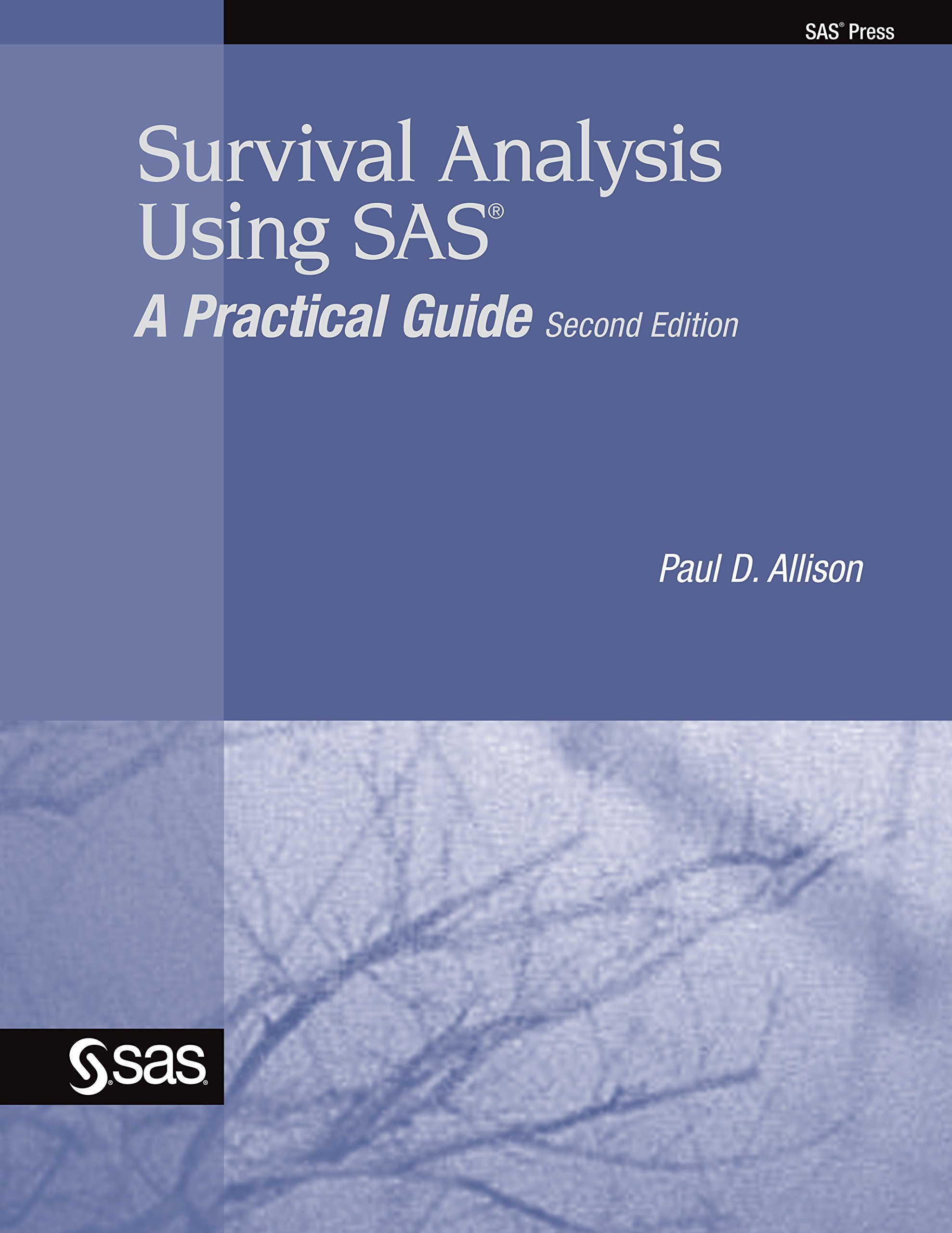Description:
Easy to read and comprehensive, Survival Analysis Using SAS: A Practical Guide, Second Edition,
by Paul D. Allison, is an accessible, data-based introduction to methods of survival analysis.
Researchers who want to analyze survival data with SAS will find just what they need with this fully
updated new edition that incorporates the many enhancements in SAS procedures for survival analysis in SAS 9.
Although the book assumes only a minimal knowledge of SAS, more experienced users will learn new techniques
of data input and manipulation. Numerous examples of SAS code and output make this an eminently practical book,
ensuring that even the uninitiated become sophisticated users of survival analysis.
The main topics presented include censoring, survival curves, Kaplan-Meier estimation, accelerated
failure time models, Cox regression models, and discrete-time analysis. Also included are topics
not usually covered in survival analysis books, such as time-dependent covariates, competing risks,
and repeated events. Survival Analysis Using SAS: A Practical Guide, Second Edition, has been thoroughly
updated for SAS 9, and all figures are presented using ODS Graphics.
This new edition also documents major enhancements to the STRATA statement in the LIFETEST procedure;
includes a section on the PROBPLOT command, which offers graphical methods to evaluate the fit of
each parametric regression model; introduces the new BAYES statement for both parametric and Cox models,
which allows the user to do a Bayesian analysis using MCMC methods; demonstrates the use of the counting
process syntax as an alternative method for handling time-dependent covariates; contains a section
on cumulative incidence functions; and describes the use of the new GLIMMIX procedure to estimate
random-effects models for discrete-time data. This book is part of the SAS Press program.
Table of Contents
PREFACE vii
Chapter 1 Introduction
What Is Survival Analysis?
What Is Survival Data?
Why Use Survival Analysis?
Approaches to Survival Analysis
What You Need to Know
Computing Notes
Chapter 2 Basic Concepts of Survival Analysis
Introduction
Censoring
Describing Survival Distributions
Interpretations of the Hazard Function
Some Simple Hazard Models
The Origin of Time
Data Structure
Chapter 3 Estimating and Comparing Survival Curves with PROC LIFETEST
Introduction
The Kaplan-Meier Method
Testing for Differences in Survivor Functions
The Life-Table Method
Life Tables from Grouped Data
Testing for Effects of Covariates
Log Survival and Smoothed Hazard Plots
Conclusion
Chapter 4 Estimating Parametric Regression Models with PROC LIFEREG
Introduction
The Accelerated Failure Time Model
Alternative Distributions
Categorical Variables and the CLASS Statement
Maximum Likelihood Estimation
Hypothesis Tests
Goodness-of-Fit Tests with the Likelihood-Ratio Statistic
Graphical Methods for Evaluating Model Fit
Left Censoring and Interval Censoring
Generating Predictions and Hazard Functions
The Piecewise Exponential Model
Bayesian Estimation and Testing
Conclusion
Chapter 5 Estimating Cox Regression Models with PROC PHREG
Introduction
The Proportional Hazards Model
Partial Likelihood
Tied Data
Time-Dependent Covariates
Cox Models with Nonproportional Hazards
Interactions with Time as Time-Dependent Covariates
Nonproportionality via Stratification
Left Truncation and Late Entry into the Risk Set
Estimating Survivor Functions
Testing Linear Hypotheses with CONTRAST or TEST Statements
Customized Hazard Ratios
Bayesian Estimation and Testing
Conclusion
Chapter 6 Competing Risks
Introduction
Type-Specific Hazards
Time in Power for Leaders of Countries: Example
Estimates and Tests without Covariates
Covariate Effects via Cox Models
Accelerated Failure Time Models
Alternative Approaches to Multiple Event Types
Conclusion
Chapter 7 Analysis of Tied or Discrete Data with PROC LOGISTIC
Introduction
The Logit Model for Discrete Time
The Complementary Log-Log Model for Continuous-Time Processes
Data with Time-Dependent Covariates
Issues and Extensions
Conclusion
Chapter 8 Heterogeneity, Repeated Events, and Other Topics
Introduction
Unobserved Heterogeneity
Repeated Events
Generalized R2
Sensitivity Analysis for Informative Censoring
Chapter 9 A Guide for the Perplexed
How to Choose a Method
Conclusion
Appendix 1 Macro Programs
Introduction
The LIFEHAZ Macro
The PREDICT Macro
Appendix 2 Data Sets
Introduction
The MYEL Data Set: Myelomatosis Patients
The RECID Data Set: Arrest Times for Released Prisoners
The STAN Data Set: Stanford Heart Transplant Patients
The BREAST Data Set: Survival Data for Breast Cancer Patients
The JOBDUR Data Set: Durations of Jobs
The ALCO Data Set: Survival of Cirrhosis Patients
The LEADERS Data Set: Time in Power for Leaders of Countries
The RANK Data Set: Promotions in Rank for Biochemists
The JOBMULT Data Set: Repeated Job Changes
References
Index 313


